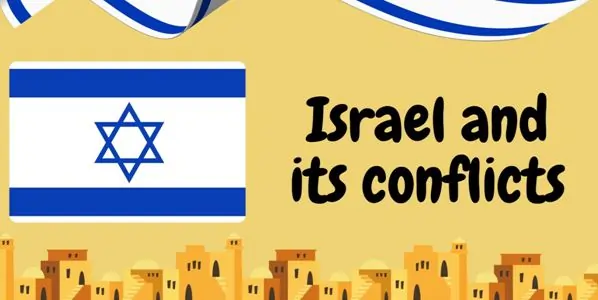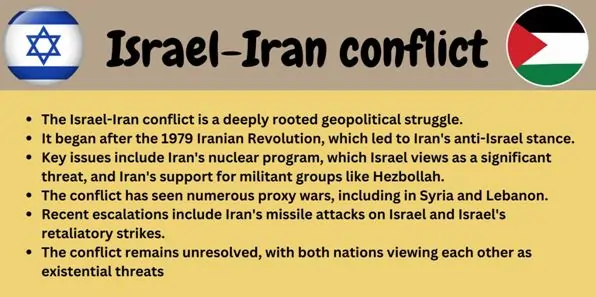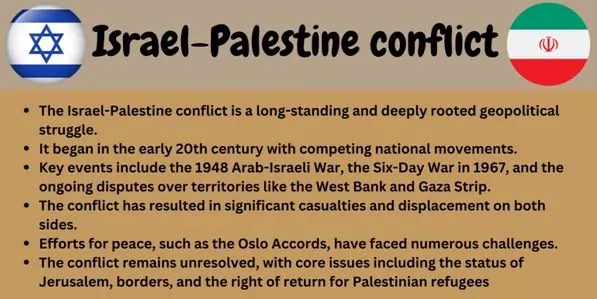
A country in Middle east well known for history and cultural. Its evolution started in the year 1948. Israel has Jews in major and only nation in the world with it. Jerusalem, its capital, has the sacred importance in Judaism, Christianity and Islam. The economy of the country is well developed with concentration on technologies, farming and tourism. With a name of the ‘Start-up Nation’, Israel has been delivering many technology titans and novel technologies. However, Israel continues to be on the receiving end, and suffer some conflicts, and jurisdictional challenges including with Palestine and Iran.
On the October the first of 2024, Iran commenced a major missile strike on Israel and fired almost two hundred ballistic missiles. According to other sources, the attack payback for the targeted killing of Iranian and Hezbollah figures by Israel. Most of the missiles were intercepted by Israel’s Iron Dome anti-missile system though a few targeted central and southern Israel. However, there were no casualties in the incident as the attack occurred and the extent of the damage is yet to be established. From this event, intensity of conflict has risen across the Middle East particularly between Israel and the United States promising to punish Tehran. This attack is the second major missile strike by Iran since April. The situation stays tense, additional escalation towards the large scale regional conflict is considered possible.
Israel-Iran conflict
The conflict between Israel and Iran is complex and long-standing geopolitical rivalry that holds geo-strategic implications for the Middle East and the entire world. This Article intends to achieve this objective by explaining the nature of the conflict between Israel and Iran.

Historical Context
Over time, this war extended from the regional level to the international one, the primary cause of which, though, can be seen in the aftermath of the Iranian revolution of 1979. Prior to the revolution in Iran, ties with Israel were amicable; furthermore, Iran was among the few nations in the Muslim world that acknowledged Israel. Nevertheless, Iran’s new rulers saw Israel as the enemy nation par excellence since the Jewish state was illegitimate in the eyes of the Islamic Republic.
The Rise of Hezbollah
As a special aspect of the conflict adjustment was Hezbollah, which is a Shiite movement operating in Lebanon. Established in 1982 and backed by Iran, Hezbollah has been directly involved in the conflict patronizing several encounters with the Israeli troops along and planning and implementing attacks on Israeli installations. Support for Hezbollah has always been a major issue between Iran and Israel since there Israel regards it as a proxy force for Iran in the Middle East.
The Nuclear Issue
The Nuclear program became a cause of concern for Israel. The Israeli government posits that Iran intends to develop nuclear weapons, despite Iran's denials. Many countries have imposed lots of sanctions on Iran with an aim of checking on nuclear advances, and the Israel has in so many instances threatened to attack Iran in its bid to prevent the country from obtaining nuclear weapons.
The 2006 Lebanon War
The 2006 Lebanon war is a major theatre in the conflict that is on-going between Israel and Iran. The start fire for the war was the kidnapping of two of the Israeli soldiers which was done by the Hezbollah and Hezbollah did this on the Israeli soil. Israel responded by launching a large scale military operation against Hezbollah in Lebanon: the second Lebanon war that lasted for a month killing and maiming many on both sides. The war disclosed the magnitude of Iran's assistance for Hezbollah and intensified the animosity between Iran and Israel.
The Syrian Civil War
The civil war that erupted in Syria in 2011 has added more to the conflict between Israel and Iran. Iran has been a major backer of the Syrian government, supplying troops and funds to enable Assad to remain in office,while on the other hand Israel has been conducting many airstrikes on Iranian interests in Syria to ensure that Iran fails to place a long term military base near it. The conflict in Syria has therefore extended to be a theatre of the fight between Israel and Iran over the leadership of the region.
The Abraham Accords
The major development in the Middle East geopolitical map was created during the year 2020 by the Abraham Accords. The deals, mediated by the Trump administration, included several Arab states, namely the UAE and Bahrain, recognize Israel. Despite these accords being seen as the peaceful settlement in the Middle East, they also showcased the intensifying rivalry between Iran and Arab nations many of which regard Iran as a greater foe. The peace agreements between Israel and several Arab countries have deepened the isolation of Iran and stepping up of confrontation with Israel.
Current Status and Challenges
To today, no comprehensive solution has been reached in the conflict between Israel and Iran and the two countries still regard each other as threats to their existence. The nuclear issue is still an important factor of contention due to Tehran’s negotiations regarding the revival of the JCPOA(joint Comprehensive Plan Of Action) signed in Vienna in 2015. This deal has been criticised vigorously by Israel arguing that the deal does not clip Iran’s nuclear ambitions adequately well.
However, the nuclear problem is not the only area in which the conflict is manifested in a number of proxy wars and regional conflicts. Therefore, some findings are an Iranian support for other militants including Hezbollah and Hamas besides the country being involved in the conflict in Syria, Iraq, and Yemen have contributed to escalating the conflict with Israel. While on the other hand there has not been success with Israel also trying to curb the influence of Iran through military confrontation as well as through friendly diplomacy further intensifying the enmity between Iran and Israel.
Conclusion
It has been clearly seen that the conflict of Israel and Iran is a long-standing conflict based on geopolitical rivalry in the Middle East region and beyond. A great deal of initiatives has been developed to address the major points of concern which rein the conflict but the problem persists. It is therefore important to take a brief look at the history of the conflict, the events that happened and those that are expected to happen in future. Thus only, there is an opportunity of dialogues, of negotiations, and only through mutual acknowledgment is it possible to expect a new beginning in the search for the fair and painless solution to this protracted conflict.
Israel and Palestine
The conflict between Israel and Palestine is one of the oldest and most intractable, political issues in the contemporary world. They originated in the period of the late nineteenth and the beginning of the twentieth centuries when nationalist trends grew stronger among the Jewish and Arab peoples of the Middle East. The conflict has witnessed different wars and uprisings and different processes of maintaining peace but has not been resolved. It’s important that in this article one goal to give an historical background enshrinement of special moments and the current state of affairs of the Israel-Palestine conflict.

Historical Context
The hostilities between Israelis and Palestinians can be traced back to Jewish and Arab nationalism in the late 1800s. Zionism the Jewish nationalist movement aspired the Jewish state in Palestine that at that time was under the Ottomans. Parallel to his process, a new movement Arab nationalism was developing; Palestinian Arabs demanded to be freed from Ottomans.
The Balfour Declaration and British Mandate
In 1917 the British government in the middle of the World War released Balfour declaration which supported the Jewish home in Palestine. After the conclusion of the war, the League of Nations assigned Britain the administration of Palestine, including the implementation of the Balfour Declaration. This time witnessed influx of Jews into Palestine and this led to conflict and Hostilities between the Jews and the Arabs.
The Establishment of Israel
In 1947, following the unsuccessful attempt by the UN to maintain Palestine as a unified entity, it was resolved to partition the territory into a Jewish state and an Arab state, while designating Jerusalem as an international zone. Whereas, the Jewish community agreed to the plan, the Arab community did not. The contemporary history of Israel commenced on May 14, 1948, with the establishment of the State of Israel, which precipitated the first Arab-Israeli war. Israel came out victorious, and with the Armistice of 1949, Israel’s territories were defined leaving the West Bank to Jordan and the Gaza Strip to Egypt.
Six Day War and its Consequences
The Six Day War was fought in June 1967 between Israel and its Arab neighbours. Egypt, Jordan and Syria were attacked by Israel in a pre-emptive strike which saw Israel occupy west Bank, Gaza Strip, Sinai Peninsula ad Golan Heights. The war changed the destiny of nations and led to occupation of Palestinian territory by Israeli forces. The UN Security Council approved the Resolution 242 demanding the Israeli withdrawal from occupied territory and the recognition of all states in the Middle East.
Oslo Accords and the Process of the Peace
Although the efforts towards achieving a diplomatic solution of the conflict were more vigorous in the nineties, The Oslo Accords of 1993 and 1995 gave tentative bases for peace settlements; afterwards, the Palestinian Authority governed was established with a measure of autonomy in some parts of the West Bank and the Gaza Strip. Nevertheless, the peace process was suffering quite a lot from different problems as new violent acts, political conflicts, and further settlement of Israelis in territories occupied since 1967.
The Second Intifada: Recent Changes
The second Palestinian uprising against the Israelis’ occupation known as Second Intifada began in 2000 making the 90s a year of violence that added to the difficulty of the peace process. The wars in Gaza in the last decade have occurred in 2008-2009, 2012, 2014 and in 2021 embrace the escalations of the conflict. Attempts to revive negotiations have been hampered by internal Israeli and Palestinian politics, regional and international alliance systems.
Current Status and Challenges
However, till now, the conflict between Israelites and Palestinians is still prevalent. This is such issues as the current and future status of Jerusalem, territorial division between Israel and a Palestinian state, refugee problem, and security arrangements for the two parties. The international community retains maximalist goals focused on the creation of two states as they were before September 1967, but to reach this goal, it is necessary to remove deep-seated trust deficits and address the concerns of both parties.
Conclusion
The conflict between Israel and Palestine is complex core and established issue which involves history, politics and society. Despite numerous attempts, peace in the society has not yet been attained to a permanent state. It is crucial to know history and the main steps of the conflict to know all what has happened to make understanding the context of the situation and the future steps.